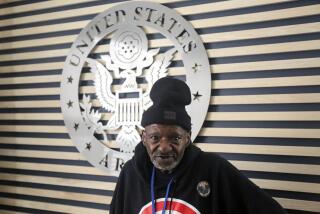Son Coming Home at Last--To Be Buried
- Share via
NEW YORK — For 17 years, John and Eugenia Bednarek were torn by the uncertainty of whether their only son was alive.
The uncertainty drove them from the house in Greenlawn, N.Y., where they reared Jonathan and his sister Joanne. It consumed their attention. And, despite continuing evidence to the contrary, they held out the hope that someday Jonathan would join them at the condominium where they now live in Ridge, N.Y.--to once again wear his clothes that they stored in the extra bedroom, to once again pick up the belongings stowed in his trunk.
“In a way, three people have been living in this condo, because we never knew, one of these days he might be back,” John Bednarek said recently.
Jonathan Bednarek is now coming home, not to live, but to be buried. And John and Eugenia Bednarek finally have the answer they have been seeking for 17 years.
Killed in 1972
Capt. Jonathan Bruce Bednarek was killed in a 1972 bombing mission over North Vietnam, where his remains stayed until they were returned to the United States late last year.
Almost immediately, military officials became convinced that Jonathan Bednarek’s remains were among 38 sets of remains--16 tentatively identified as those of American servicemen--handed over to the U.S. government in December, his father said. The Bednareks were told shortly afterward that the process to identify their son’s remains had begun.
“All these years we didn’t know what to grieve for, because we didn’t know if he was dead or alive,” said John Bednarek, who is 78. “Let me tell you, it shook us up. At last we knew, but it wasn’t the news we wanted.”
Recently, the officials told the Bednareks that the identification process was almost complete. They said that the family could arrange funeral services for their son, one of 29 Long Islanders listed as unaccounted for after military action in Southeast Asia, and the first whose remains have been identified and sent home to Long Island for burial since the war ended.
An honors high school student in Greenlawn who graduated magna cum laude with an ROTC commission at Manhattan College, Bednarek had served just one month and one day as an Air Force captain when he was reported missing in action on April 18, 1972, at age 23. Air Force officials said that the F-4 Phantom jet he was navigating was on a bombing raid over Ha Bac province, about 35 miles northeast of Hanoi.
Bednarek’s remains were charred, leading forensic analysts to conclude that his F-4 jet was downed and that he died in the crash, his father said. The Vietnamese also furnished an identification card with Bednarek’s name and photograph, “which means they knew all these years that he was dead and never told us,” he added. “Of all the grief and anger, that realization may have been the worst.”
Larry Belcher, a spokesman for the U.S. Pacific Command, which oversees the U.S. Army Central Identification Laboratory in Honolulu, said that he could not yet release details on the Bednarek case. But he said that each identification is a “painstaking” process, where teams of experts sift through remains and match them against computerized medical records, searching for a bone fracture or a tooth setting that may unlock the key to an identity.
Move From Home
A year after their son disappeared, the Bednareks moved from their house on Oakwood Street, a quiet one-way street in Greenlawn where they had reared Jonathan and their daughter Joanne, who is now 49 and lives in Florida.
“We couldn’t take it any more, to be in the house he had grown up in,” Bednarek said. He and his wife now live in a retirement community in Ridge.
But friends and neighbors still remember the Bednareks and the pride they showed when their son enlisted--as well as the shock when they learned he was missing.
The Bednareks were regarded as “very nice, very friendly people,” said Albert Dicesare, who still lives next door to the family’s former home. He described the son--whom neighbors knew by his middle name, Bruce--as a friendly, outgoing boy who liked to build models of battleships and fighter planes.
‘Very, Very Proud’
When Bednarek joined the Air Force, his parents were “very, very proud of the fact that he was a flier and that he was flying for his country,” Dicesare said.
Dicesare remembers looking out the window one day in 1972 and seeing two or three officers “wearing a lot of brass” knock on the Bednareks’ front door. “I saw them come in . . . ,” he said. “After that, they did change. They weren’t the same happy-go-lucky couple. They were preoccupied, and of course, it was because of their son.”
Alice Rickard, the Bednareks’ other former next-door neighbor on Oakwood Street, remembers another knock on their front door a few weeks later. “I remember when they shipped back his trunk, she was very upset. She left it in the hall, and she wouldn’t open it until her husband got home. They were just devastated when their son was shot down.”
Like many other servicemen who failed to return from the Vietnam War, Bednarek was initially listed as a prisoner of war, and each time the names of freed prisoners were announced, the family’s hope was buoyed. But a few years after the war ended, his status was changed to missing in action. In 1979, along with most others previously listed as MIAs and POWs, his status was changed to “presumed dead.” Bednarek was awarded the Purple Heart and the Distinguished Flying Cross.
2,357 Unaccounted For
All told, U.S. forensic experts have identified the remains of 226 other Americans who served in the Vietnam War. Another 2,357 Americans who served in Vietnam are still unaccounted for, Pentagon officials said. Of those, 1,723 were last seen in Vietnam, 545 in Laos, 83 in Cambodia and six in China.
“We cannot rule out the possibility that some Americans are still alive or are being detained against their will in Vietnam since the fall of Saigon in 1975, but we are unable to prove it,” said Lt. Cmdr. Jim Kudla, a Pentagon spokesman. The government is still investigating reported sightings of about 140 U.S. servicemen in Southeast Asia, he said.
Around the country, the debate continues over whether the U.S. government is doing enough to find military personnel still missing in Southeast Asia. “Initially, a lot of us were critical of both governments’ efforts to find those missing in Vietnam,” said Rep. Robert J. Mrazek (D-N.Y.), who has been active in U.S.-Vietnam issues. But he said since the 1987 visit by Gen. John W. Vessey Jr. to Vietnam to discuss the problem with the Vietnamese, “I think both sides are working hard to resolve this issue.”
Receive Confirmation
For the Bednareks, five more agonizing months passed after the December call before the Bednareks received the recent confirmation that forensic teams at the laboratory in Hawaii had successfully matched the remains against their son’s medical records.
And that has brought some relief to Ed Ferraro, a 42-year-old Vietnam veteran who is vice president of the Freedom Foundation, a group that promotes public awareness of missing servicemen. Ferraro has been wearing a POW-MIA bracelet with Bednarek’s name on it for two years.
“When I got up and dressed and put on the bracelet, I’d look at the guy’s name and wonder what kind of man he was, how he got shot down. . . . If they are his remains, and the family is willing to accept his remains, I’m relieved,” Ferraro said.
More to Read
Sign up for Essential California
The most important California stories and recommendations in your inbox every morning.
You may occasionally receive promotional content from the Los Angeles Times.










